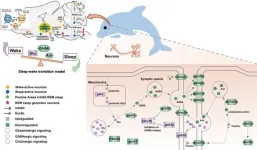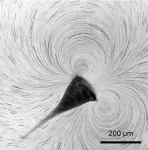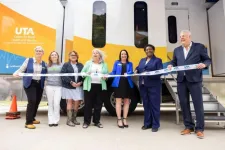(Press-News.org) While the Middle Paleolithic period is viewed as a dynamic time in European and African history, it is commonly considered a static period in East Asia. New research from the University of Washington challenges that perception.
Researchers discovered a complete Quina technological system — a method for making a set of tools — in the Longtan site in southwest China, which has been dated to about 50,000 to 60,000 years ago. Quina technology was found in Europe decades ago but has never before been found in East Asia.
The team published its findings March 31 in Proceedings of the National Academy of Sciences.
“This is a big upset to the way we think about that part of the world in that period of time,” said Ben Marwick, co-author and UW professor of archaeology. “It really raises the question of, what else were people doing during this period that we haven’t found yet? How is this going to change how we think about people and human evolution in this area?”
The Middle Paleolithic, or Middle Stone Age, occurred about 300,000 to 40,000 years ago and is considered a crucial time in human evolution. The period is associated with the origin and evolution of modern humans in Africa. In Eurasia, it’s linked to the development of several archaic human groups such as Neanderthals and Denisovans. However, there is a widely held belief that development in China was sluggish during most of the Paleolithic.
The Quina system identified in China has been dated to 55,000 years ago, which is in the same period as European finds. This disputes the idea that the Middle Paleolithic was stagnant in the region and deepens the understanding of Homo sapiens, Denisovans and possibly other hominins.
The most distinctive part of the Quina system is the scraper — a stone tool that is typically thick and asymmetrical with a broad and sharp working edge that has clear signs of use and resharpening. Researchers found several of these, as well as the byproducts of their manufacture. Tiny scratches and chips on the tools indicate they were used for scraping and scratching bones, antlers or wood.
Marwick said the question now becomes: how did this toolkit arrive in East Asia? Researchers will work to determine whether there is a direct connection — people moving gradually from west to east — or if the technology was invented independently with no direct contact between groups.
It will help if researchers can find an archaeological site with a deep set of layers, Marwick said, so they can see what tools developed before the appearance of Quina technology.
“We can try to see if they were doing something similar beforehand that Quina seemed to evolve out of,” Marwick said. “Then we might say that development seems to be more local — they were experimenting with different forms in previous generations, and they finally perfected it. Alternatively, if Quina appears without any sign of experimentation, that suggests this was transmitted from another group.”
There are likely several reasons why Quina technology has just now been found in East Asia. One factor, Marwick said, is that archaeologists working in China are learning more about archaeology in other parts of the world and how to recognize their findings. He said the pace of research is also increasing, which means archaeologists are more likely to find rarer artifacts.
“The idea that nothing has changed for such a long time in East Asia also has a tight grip on people,” Marwick said. “They haven’t been considering the possibility of finding things that challenge that. Now maybe there are some scholars who are interested in questioning those ideas.”
Much of archaeological discovery relies on luck, Marwick said, but one goal for the future is to uncover human remains in the area.
“That could answer the question of whether these tools are the product of a modern human like you and me,” Marwick said. “There have never been any Neanderthals found in East Asia, but could we find a Neanderthal? Or, more likely, could we find a Denisovan, which is another kind of human ancestor? If we can find the human remains associated with this period, we might find something surprising — maybe even a new human ancestor that we don't know about yet.”
Other co-authors were Qi-Jun Ruan, Hao L, Pei-Yuan Xiao, Ke-Liang Zhao, Zhen-Xiu Jia and Fa-Hu Chen of the Chinese Academy of Sciences; Bo Li of the University of Wollongong in Australia, Hélène Monod of the Universitat Rovira i Virgili in Spain; Alexander Sumner of DePaul University; Jian-Hui Liu of the Yunnan Provincial Institute of Cultural Relics and Archaeology; Chun-Xin Wang and An-Chuan Fan of the University of Science and Technology of China; Marie-Hélène Moncel of the National Museum of Natural History in Paris; Marco Peresani and Davide Delpiano of the University of Ferrara in Italy; and You-Ping Wang of Peking University in Beijing.
The research was funded by the National Natural Sciences Foundation of China, the Open Research Fund of TPESER, the National Natural Science Foundation of China, the Australian Research Council and the University of Ferrara.
For more information, contact Marwick at bmarwick@uw.edu.
END
Discovery of Quina technology challenges view of ancient human development in East Asia
2025-03-31
ELSE PRESS RELEASES FROM THIS DATE:
Whales and dolphins sleep by turning off one half of their brains at a time; scientists discover more about the genes and pathways that enable this phenomenon
2025-03-31
Whales and dolphins sleep by turning off one half of their brains at a time; scientists discover more about the genes and pathways that enable this phenomenon.
####
Article URL: https://plos.io/4c9g5gm
Article Title: Evolution of canonical circadian clock genes underlies unique sleep strategies of marine mammals for secondary aquatic adaptation
Author Countries: China
Funding: This work was supported by the National Key Research and Development (R&D) Program of China (grant no. 2022YFF1301600) to G.Y. & S.X., the Key Project ...
A new clue to how multicellular life may have evolved
2025-03-31
Life emerged on Earth some 3.8 billion years ago. The “primordial soup theory” proposes that chemicals floating in pools of water, in the presence of sunlight and electrical discharge, spontaneously formed organic molecules. These building blocks of life underwent chemical reactions, likely driven by RNA, eventually leading to the formation of single cells.
But what sparked single cells to assemble into more complex, multicellular life forms?
Nature Physics published a new insight about a possible driver of this key step in evolution — the fluid ...
ALL ALS consortium launches website to advance ALS research
2025-03-31
ALL ALS Consortium Launches Website to Advance ALS Research
The Access for All in ALS (ALL ALS) Consortium announced the launch of its official website, creating a central hub for information about its initiatives and clinical research studies. ALL-ALS.org is designed to inform and engage researchers, clinicians, and current and prospective study participants.
The ALL ALS Consortium formed in fall 2023 with funding from the National Institutes of Health (NIH). The consortium consists of 35 clinical sites in the United States and Puerto Rico, led by researchers at Barrow Neurological Institute in Phoenix, Arizona and Massachusetts ...
Many TB cases may have gone undetected in prisons in Europe and the Americas during COVID-19
2025-03-31
EMBARGOED UNTIL 6:30 P.M. EST on Monday, March 31, 2025
Contact:
Jillian McKoy, jpmckoy@bu.edu
Michael Saunders, msaunder@bu.edu
##
Many TB Cases May Have Gone Undetected in Prisons in Europe and the Americas During COVID-19
A new study found that reported diagnoses for tuberculosis were consistently lower than expected throughout the pandemic, even though incarceration rates remained largely consistent and TB detection among the general population managed to reverse after an early-pandemic decline.
Incarcerated populations have a high risk of developing tuberculosis ...
Predicting older people’s frailty helps doctors intervene earlier
2025-03-31
UNDER EMBARGO UNTIL 00.01 AM BST ON TUESDAY 1 APRIL
The new Electronic Frailty Index 2 (eFI2) is now available to 60% of England’s GPs thanks to research funded by the National Institute of Health and Care Research (NIHR) and conducted by researchers at the University of Leeds and UCL
GP data on 36 health problems such as dementia, falls and fractures will help medical professionals to more accurately identify older people’s frailty and intervene earlier
Interventions may include a holistic assessment and treatment plan, falls prevention, targeted medicines review, and resistance exercise ...
New study validates lower limits of human heat tolerance
2025-03-31
A study from the University of Ottawa’s Human and Environmental Physiology Research Unit (HEPRU) has confirmed that the limits for human thermoregulation—our ability to maintain a stable body temperature in extreme heat—are lower than previously thought.
This research, led by Dr. Robert D. Meade, former Senior Postdoctoral Fellow and Dr. Glen Kenny, Director of HEPRU and professor of physiology at uOttawa's Faculty of Health Sciences, highlights the urgent need to address the impacts of climate change on human health.
The study found that many regions may soon experience heat and humidity levels that exceed the safe limits ...
UTA takes lead with mobile lab to address rural health care crisis
2025-03-31
Texas has the most rural residents of any state, with nearly 3 million people spread across a vast landscape. If rural Texas were its own state, it would rank as the 36th most populous.
Yet, rural Texans face significant barriers to health care that their urban counterparts do not. More than a quarter of the state’s 172 rural counties lack a hospital, and those with at least one hospital often struggle with a shortage of qualified health care personnel, such as nurses and first responders.
To address these growing challenges, The University of Texas at Arlington introduced its new Mobile Simulation Lab on Friday. It’s the first in Texas dedicated ...
New flexible hydrogel could improve drug delivery for post-traumatic osteoarthritis treatment
2025-03-31
Post-traumatic osteoarthritis (PTOA) is a condition that affects joints after an injury. Current treatments focus on relieving symptoms but do not prevent or stop the progression of the condition. Although emerging therapies have shown promise in preclinical studies, a major obstacle is delivering these therapies effectively into the joint, a highly dynamic environment subjected to constant mechanical stress. Researchers at Mass General Brigham have created a new hydrogel to improve drug delivery for treating PTOA. The hydrogel, ...
Association for Molecular Pathology celebrates U.S. District Court’s decision to vacate FDA rule on laboratory-developed test procedure regulation
2025-03-31
ROCKVILLE, Md. – March 31, 2025 – The Association for Molecular Pathology, the premier global molecular diagnostic professional society, and pathologist Michael Laposata, M.D., Ph.D., today announced a favorable ruling in their lawsuit against the U.S. Food and Drug Administration over the regulation of laboratory-developed test procedures. The ruling by Judge Sean D. Jordan of the U.S. District Court for the Eastern District of Texas granted AMP’s motion for summary judgment ...
Dr. Christopher Kramer is new American College of Cardiology President
2025-03-31
Christopher M. Kramer, MD, FACC, today assumed the role of president of the American College of Cardiology, an almost 60,000-member global cardiovascular organization working to transform cardiovascular care and improve heart health for all.
“I see significant challenges and opportunities for the field of cardiology in the coming years, including workforce issues, health equity, diversity and inclusion, and AI-driven solutions, that need to be addressed to achieve ACC’s mission of transforming cardiovascular care for all,” ...




